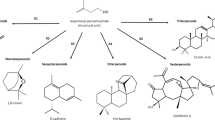Abstract
A method to determine 15 intact glucosinolates (epiprogoitrin; glucoalyssin; glucobrassicanapin; glucobrassicin; glucoerucin; glucoiberin; gluconapin; gluconasturtiin; glucoraphanin; glucotropaeolin; 4-hydroxyglucobrassicin; 4-methoxyglucobrassicin; neoglucobrassicin; progoitrin; sinigrin) in bee pollen has been proposed, by means of ultra-high liquid chromatography coupled to a quadrupole time-of-flight mass detector. Efficient sample treatment (with average analyte recoveries between 80 and 96%) involving a solid-liquid extraction with hot water, followed by solid-phase extraction with a weak anion exchange sorbent (NH2), was employed to analyze those intact glucosinolates in bee pollen. Chromatographic analysis (15 min) was performed on a fully porous silica–based column (Luna® Omega C18) with a mobile phase composed of a mixture of acetonitrile (0.1% formic acid) and water (0.1% formic acid) in gradient elution mode at a flow rate of 0.2 mL/min. Accordingly, the analytical performance of the proposed method was evaluated, and it was then applied to determine intact glucosinolates in commercial bee pollen samples from different Spanish regions. Ten intact glucosinolates were identified in certain samples over a wide concentration range.



Similar content being viewed by others
References
Alarcón-Flores MI, Romero-González R, Martínez Vidal JL, Garrido Frenich A (2013) Multiclass determination of phytochemicals in vegetables and fruits by ultra high performance liquid chromatography coupled to tandem mass spectrometry. Food Chem 141:1120–1129. https://doi.org/10.1016/j.foodchem.2013.03.100
Ares AM, Bernal J, Nozal MJ, Turner C, Plaza M (2015a) Fast determination of intact glucosinolates in broccoli leaf by pressurized liquid extraction and ultra high performance liquid chromatography coupled to quadrupole time-of-flight mass spectrometry. Food Res Int 76:498–505. https://doi.org/10.1016/j.foodres.2015.06.037
Ares AM, Nozal MJ, Bernal J (2015b) Development and validation of a liquid chromatography-tandem mass spectrometry method to determine intact glucosinolates in bee pollen. J Chromatogr B 1000:49–56. https://doi.org/10.1016/j.jchromb.2015.07.017
Ares AM, Nozal MJ, Bernal JL, Bernal J (2016) Analysis of intact glucosinolates in beeswax by liquid chromatography tandem mass spectrometry. Food Anal Methods 9:795–804. https://doi.org/10.1007/s12161-015-0234-3
Ares AM, Valverde S, Bernal JL, Nozal MJ, Bernal J (2018) Extraction and determination of bioactive compounds from bee pollen. J Pharm Biomed Anal 147:110–124. https://doi.org/10.1016/j.jpba.2017.08.009
Dungey SD, Sang JP, Rothnie NE, Palmer MV, Burke DG, Knox RB, Williams EG, Hilliard EP, Salisbury PA (1988) Glucosinolates in the pollen of rapeseed and Indian mustard. Phytochemistry 27:815–817. https://doi.org/10.1016/0031-9422(88)84098-6
Gałuszka A, Migaszewski Z, Namieśnik J (2013) The 12 principles of green analytical chemistry and the SIGNIFICANCE mnemonic of green analytical practices. Trends Anal Chem 50:78–84. https://doi.org/10.1016/j.trac.2013.04.010
Glauser G, Schweizer F, Turlings TCJ, Reymond P (2012) Rapid profiling of intact glucosinolates in Arabidopsis leaves by UHPLC–QTOFMS using a charged surface hybrid column. Phytochem Anal 23:520–528. https://doi.org/10.1002/pca.2350
International Conference on Harmonization (2005) ICH topic Q2 (R1), Validation of analytical procedures: text and methodology. https://www.ich.org/fileadmin/Public_Web_Site/ICH_Products/Guidelines/Quality/Q2_R1/Step4/Q2_R1__Guideline.pdf Accessed 03 Jan 2019
Kaškonienė V, Ruočkuvienė G, Kaškonas P, Akuneca I, Maruška A (2015) Chemometric analysis of bee pollen based on volatile and phenolic compound compositions and antioxidant properties. Food Anal Methods 8:1150–1163. https://doi.org/10.1007/s12161-014-9996-2
Klopsch R, Witzel K, Börner A, Schreiner M, Hanschen FS (2017) Metabolic profiling of glucosinolates and their hydrolysis products in a germplasm collection of Brassica rapa turnips. Food Res Int 100:392–403. https://doi.org/10.1016/j.foodres.2017.04.016
Klopsch R, Witzel K, Artemyeva A, Ruppel S, Hanschen FS (2018) Genotypic variation of glucosinolates and their breakdown products in leaves of Brassica Rapa. J Agric Food Chem 66:5481–5490. https://doi.org/10.1021/acs.jafc.8b01038
Pascoal A, Rodrigues S, Teixeira A, Feás X, Estevinho LM (2014) Biological activities of commercial bee pollens: antimicrobial, antimutagenic, antioxidant and anti-inflammatory. Food Chem Toxicol 63:233–239. https://doi.org/10.1016/j.fct.2013.11.010
Phenomenex (2018) Luna Omega brochure. https://az621941.vo.msecnd.net/documents/6340a07c-e563-4342-87b0-305468f0c8f6.pdf Accessed 03 Jan 2019
Shi H, Zhao Y, Sun J, Yu L, Chen P (2017) Chemical profiling of glucosinolates in cruciferous vegetables-based dietary supplements using ultra-high performance liquid chromatography coupled to tandem high resolution mass spectrometry. J Food Compos Anal 61:67–72. https://doi.org/10.1016/j.jfca.2017.01.018
Siqueira JS, Pereira JB Jr, Lemos MS, Dantas Filho HA, Fernandes Dantas KG (2017) Optimization of a digestion method using diluted acid in bee pollen samples for determination of Fe, Mn and Zn by flame atomic absorption spectrometry. Food Anal Methods 10:759–763. https://doi.org/10.1007/s12161-016-0625-0
Thompson M, Ellison SL, Wood R (2002) Harmonized guidelines for single laboratory validation of methods of analysis (IUPAC Technical Report). Pure Appl Chem 74:835–855. https://doi.org/10.1351/pac200274050835
Acknowledgements
The authors wish to thank David Rixham (White Rose English School, Valladolid, Spain) for performing the English revision and the “Laboratorio de Técnicas Instrumentales” (University of Valladolid) for using its UHPLC-QTOF system.
Funding
This work was funded by Project RTA2015-00013-C03-03.
Author information
Authors and Affiliations
Corresponding author
Ethics declarations
Conflict of Interest
José Bernal declares that he has no conflict of interest. David González declares that he has no conflict of interest. Silvia Valverde declares that she has no conflict of interest. Laura Toribio declares that she has no conflict of interest. Ana M. Ares declares that she has no conflict of interest.
Ethical Approval
This article does not contain any studies with human participants or animals performed by any of the authors.
Informed Consent
Not applicable
Additional information
Publisher’s Note
Springer Nature remains neutral with regard to jurisdictional claims in published maps and institutional affiliations.
Rights and permissions
About this article
Cite this article
Bernal, J., González, D., Valverde, S. et al. Improved Separation of Intact Glucosinolates in Bee Pollen by Using Ultra-High-Performance Liquid Chromatography Coupled to Quadrupole Time-of-Flight Mass Spectrometry. Food Anal. Methods 12, 1170–1178 (2019). https://doi.org/10.1007/s12161-019-01446-2
Received:
Accepted:
Published:
Issue Date:
DOI: https://doi.org/10.1007/s12161-019-01446-2




